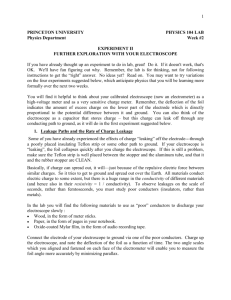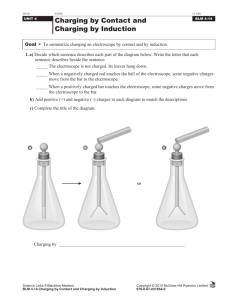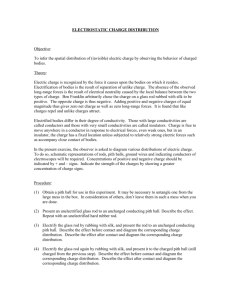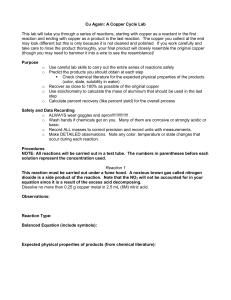PRINCETON UNIVERSITY PHYSICS 104 LAB
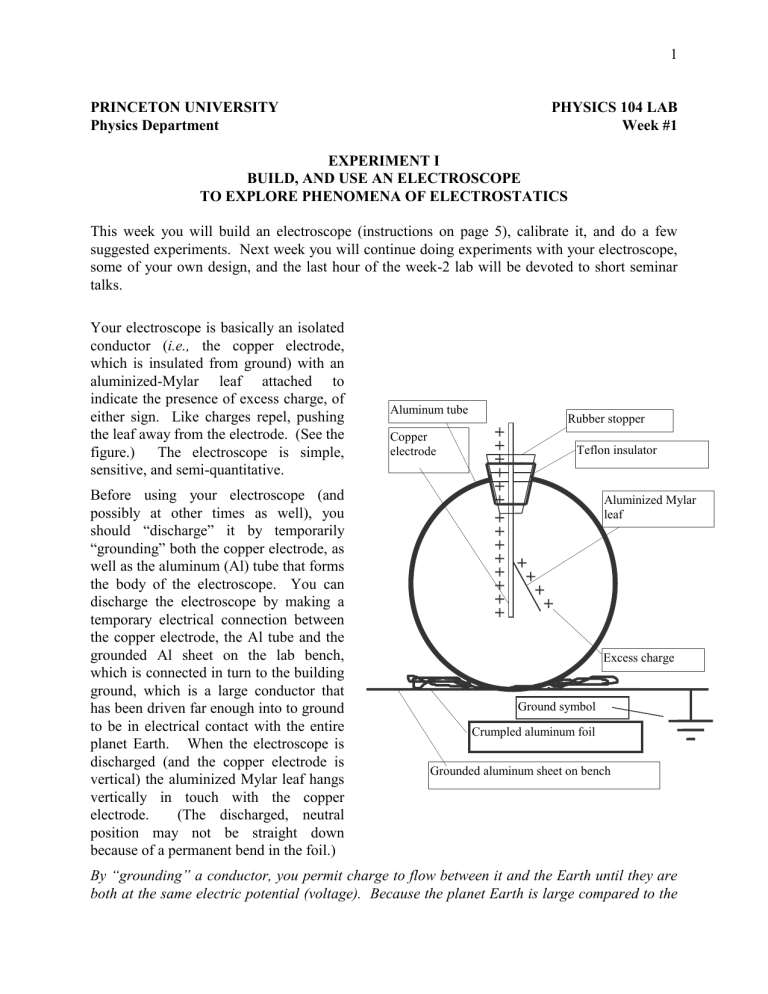
1
PRINCETON UNIVERSITY
Physics Department
PHYSICS 104 LAB
Week #1
EXPERIMENT I
BUILD, AND USE AN ELECTROSCOPE
TO EXPLORE PHENOMENA OF ELECTROSTATICS
This week you will build an electroscope (instructions on page 5), calibrate it, and do a few suggested experiments. Next week you will continue doing experiments with your electroscope, some of your own design, and the last hour of the week-2 lab will be devoted to short seminar talks.
Your electroscope is basically an isolated conductor ( i.e., the copper electrode, which is insulated from ground) with an aluminized-Mylar leaf attached to indicate the presence of excess charge, of either sign. Like charges repel, pushing the leaf away from the electrode. (See the figure.) The electroscope is simple, sensitive, and semi-quantitative.
Aluminum tube
Copper electrode
Rubber stopper
Teflon insulator
Before using your electroscope (and possibly at other times as well), you should “discharge” it by temporarily
“grounding” both the copper electrode, as well as the aluminum (Al) tube that forms the body of the electroscope. You can discharge the electroscope by making a temporary electrical connection between the copper electrode, the Al tube and the grounded Al sheet on the lab bench, which is connected in turn to the building ground, which is a large conductor that has been driven far enough into to ground to be in electrical contact with the entire planet Earth. When the electroscope is discharged (and the copper electrode is vertical) the aluminized Mylar leaf hangs vertically in touch with the copper electrode. (The discharged, neutral position may not be straight down because of a permanent bend in the foil.)
Ground symbol
Crumpled aluminum foil
Aluminized Mylar leaf
Excess charge
Grounded aluminum sheet on bench
By “grounding” a conductor, you permit charge to flow between it and the Earth until they are both at the same electric potential (voltage). Because the planet Earth is large compared to the
2 size of your conductor, the final voltage of the Earth + conductor is extremely close to the initial voltage of the Earth. Therefore the voltage of the Earth is essentially unperturbed by your actions, and provides a practically stable reference voltage in the laboratory, which we define to be zero Volts.
In practice, your body is a reasonably good “ground” (charge leaks off through your shoe soles), so when you don't have a convenient ground wire, just touch the tip of the copper electrode momentarily to discharge it.
Also, you can discharge the electroscope leaf by simultaneously touching a finger to the electrode and your thumb to the aluminum tube, provided that the Al tube is grounded. The charge that flows through your hand is too small to feel.
Now for some experiments to get you started. Be alert for novel experimental ideas of your own. design. Amaze your colleagues and instructor.
Sign of Charge
Ben Franklin discovered that electric charge comes in two kinds, which he called positive and negative. (To this day there is no fundamental understanding of why this is true, while mass—gravity's source—has only one sign. However, these facts are related to the quantum facts that the “spin” of the photon is odd, while the spin of the graviton is even.)
He arbitrarily defined the charge left on glass, after rubbing with silk, as positive. Using this definition, devise experiments to:
1. Demonstrate that there are two kinds of charge.
Previously
Charged
Electroscope
Determines the sign of charge
2. Determine the sign of the charge on various objects that are provided on your bench. Try rubbing different rods with different materials and then devise methods of determining the sign of the charge produced.
Charging the Electrometer by Two Methods
When experimenting as suggested above you may have noticed that there are two ways to get the leaf to deflect.
Induction: You can bring a charged object close to the electrode (but not so close as to hear a snap of a spark jumping), and see a deflection that goes away when you withdraw the charged
Charged separated by
Induction
Charged by
Conduction
3 object to a large distance. This is called induction.
Your charged object is attracting charge (of the opposite sign to that on the object) to the top of the copper electrode, and repelling charge of the same sign, leaving the bottom end of the electrode, and the Mylar leaf, with a net charge sufficient to cause a deflection between the Mylar and the copper. See first figure on the left on p. 2.
A procedure to convert the temporary charging by induction into a more permanent state is considered below under the heading of the electrophorus.
Conduction: However, if you touch the charged object to the copper electrode, or place them close enough to cause charge to jump across the air gap (snap), then you deposit some net charge on the electrode. When you take the source (charged object) away, the leaf will not go back to the neutral, discharged position. You can, of course, neutralize the electrode by touching it and the ground simultaneously.
Devise some experiments to demonstrate inductive and conductive charge transfer. Be sure that you understand the sign of the charge on the Mylar leaf at all times. Use sketches in your notebook to explain what is going on in each of your experiments
The Electrophorus
In the remainder of this lab project you will often need to charge some conductor, e.g., the coffee cans. An easy way to accumulate a sizable charge on a conductor is to use an apparatus similar to what you saw in lecture: an electrophorus that can be charged by a sequence of induction, followed by selective discharge by conduction.
In the laboratory you will find some one-foot-square conductors attached to an insulating handle so that you can hold and transport it without discharging it. Now if you charge up a piece of polystyrene (the light blue pieces of Styrofoam) by rubbing it with fur, and bring the originally neutral conducting square above it but not touching it (if you do it will still work, but not as well), you will induce a separation of charge in the conductor. Next, touch the top of the conducting square with your finger (or a grounded conductor), while the polystyrene is still near the conducting square. This will remove (pass to ground) charge of one sign (which?) that had been induced on the top surface of the conducting square, leaving it with a net charge. Then move the polystyrene away from the conducting square. What, if anything, happens to the total charge and to the distribution of charge on the conducting square?
You can now use the charged, conducting square to charge up any object you want by touching the conducting square to it. Furthermore, you can repeat the charging operation on the square as long as the polystyrene holds its charge. If you perform the charging operation twice in a row, does the conducting square accumulate twice as much charge?
Capacity vs. Size?
Your lab apparatus includes a Ping-Pong ball that has a conducting surface, which can therefore be used to accumulate and transfer charge. Make a small aluminum ball out of foil and attach it to a Lucite rod. The aluminum ball should be significantly smaller than the Ping-Pong ball, say about 0.5” in diameter.
Charge up one of the large insulated coffee cans using your electrophorus. Now transfer charge from the charged coffee can to your electroscope by touching the Ping-Pong ball to the coffee
4 can, thus sharing its charge with the ball and then with the electroscope. Note the deflection on the Mylar leaf.
Now ground the electroscope and repeat the procedure, this time using the aluminum ball instead of the Ping-Pong ball to transfer the charge to the electroscope. Is there a difference in the amount of deflection? Can you explain why?
Charge up your coffee can with the electrophorus again. Now transfer charge from the coffee can to the electroscope using the Ping-Pong ball repeatedly without grounding it each time. Explain what you see. Estimate the fraction of the coffee can’s charge transferred to the electroscope at each touch of the Al ball?
Hollow Conductor
Using your coffee can and the Ping-Pong ball, devise an experiment to demonstrate that charge on a hollow conductor resides primarily on the outside surface, with almost no charge on the inside surface.
Behavior of Sharp Points
To explain the operation of the Van de Graff generator, another charging machine which you saw in lecture and will use in the lab, you need to understand that a spark jumps non-conductor belt carries from or to a sharp (very small radius of charge up curvature) point, much more easily than from or to a surface with a large radius of curvature. Using the sewing machine needle, and other object on your lab bench, devise and carry out an experiment to show that this is true. Be as quantitative as possible as to how “easily” sparks can be made to occur. power supply points spray charge on belt
Points take charge off belt---they flow to surface of metal sphere motorized drive shaft
Ding Dong
Get two empty coffee cans; charge one of them and ground the other. Set them an inch or two apart and dangle a small (about ¼” dia.) aluminum ball between them. Describe and explain what happens.
Calibration
Your electroscope is so sensitive that it's very hard to measure the amount of charge needed for a given deflection. Instead, you can determine the deflection vs.
electric potential (voltage) difference from a power supply.
Attach angle scales to both Plexiglas faces of the electroscope. Align the scales so that the zero angle lines and the face of the copper conductor are in the same plane, and so that the bend in the hinged leaf lines up with the intersection of the diverging lines that indicate the angles. Connect your electroscope to the variable high voltage source, and make measurements of deflection vs.
voltage. (Be careful of parallax.)
5
Your calibrated electroscope can now be called an Electrometer, and can be used as a high- voltage voltmeter
. (“Scope” from Greek scopion, to see; “Meter” from Greek metron, to measure.)
Errors. Estimate and record the errors you make in reading the deflection. You should be able to read the angle scale to within + 5 o
. Plot a graph of voltage/deflection (volts vs.
degree) and show your estimated error as an error bar on each of your data points (you may assume that the power supply has no error to the accuracy to which we are working). Draw a “best fit” straight line. (Would you expect the line to go through the point (0,0)?) Assuming that the straight line is a good approximation to the calibration curve, deduce a value for voltage/deflection + error (in volts per degree). To estimate the error, draw a line above your “best fit” line that, while not
“best,” would still be borderline acceptable, given your error bars, and use its slope as the upper limit on the error, as sketched in the figure below. To find the lower limit on the error, do the same for a line below the “best fit” line.
Line above
“best fit”, upper limit of slope.
Degrees
30
20
10
0
60
50
40
Line below
“best fit”, lower limit of slope
Volts
6
How to build your very own Electroscope
REMEMBER
BRING YOUR ELECTROMETER TO LAB NEXT WEEK (or leave in lab)
Here are a few instructions on how to assemble your take-home electroscope.
Begin with the following parts:
- One copper bar to be used as an electrode.
- One rubber stopper with a hole for the bar.
- One aluminum tube with a hole for the stopper.
- Two pieces of Plexiglas.
- One package of 5 min epoxy and a stirrer.
- One Teflon band.
- One piece of thin aluminized Mylar.
NOTE : As you may very well have guessed, there is a good reason why this stuff is called 5-minute epoxy. In about five minutes after the mixing is complete it will cure and get hard, so you have less than five minutes to stick everything together. However there is enough time for you to assemble everything if you plan ahead and follow the directions. Read the rest of the instructions carefully before proceeding.
Step 1: The Plexiglas is covered on both sides with protective paper. Peel the paper off one side of each piece.
Step 2: Get a piece of aluminum foil on which to mix the epoxy. Fold the epoxy packet and squeeze the contents to one end and tear the packet open on the other end. Squeeze out the contents of both pouches on the foil and mix vigorously with the wooden stirrer provided. Make sure you get all the epoxy out. Mix the epoxy until the mixture is not transparent anymore. Mix for another 10 seconds. Now it is ready for use.
Step 3: With care, take some epoxy at the end of the wooden stirrer and apply it to one end of the aluminum tube. Do this all the way around. Do not use too much epoxy, as it will run down the side of the tube.
Step 4: Place one of the Plexiglas ends in front of you on the table with the clear side up and carefully put the epoxied end of the aluminum tube on it symmetrically.
Do not slide the tube once it is on the Plexiglas.
You want a little bead of epoxy to squeeze out around the edges of the tube. Make sure the hole in the aluminum tube is directly aligned in the middle of the 4” dimension of the Plexiglas so that it will be straight up. (See figure on next page).
Step 5: With the electroscope laying on its newly epoxied end carefully apply epoxy with the stirrer to the other end of the tube. Make sure not to drip any on the Plexiglas. If by any chance you drip some epoxy do not try to wipe it off, just leave it and it will harden cleaner this way .
7
Now take the other piece of Plexiglas and carefully lower its clear surface onto the end of the tube. Make sure you lower it slowly and put it down right where you want it in order to prevent smearing the epoxy.
Step 6: At this point both pieces of Plexiglas are epoxied to the aluminum tube and the electroscope is laying on the table on one end. Using a rigid ruler or straight edge make sure that the two pieces of Plexiglas are square with each other. If not, carefully rotate the end, check that the hole is lined up also. Now leave the electroscope and let the epoxy completely cure and harden. This takes about 10 minutes. Check your extra epoxy on the foil to judge hardness.
After the epoxy is completely cured slowly peel the paper on the other side of both Plexiglas pieces. The following figure shows the assembled electroscope through one of the Plexiglas ends.
copper bar rubber stopper (wrapped in teflon)
Teflon insulator aluminum tube plexiglass end
Crumpled Aluminum foil aluminum grounding sheet aluminized Mylar
End view of the electroscope.
Step 7: Take the rubber stopper and push the copper bar through the hole so that about two inches of the bar sticks out the small end of the rubber stopper. Next take the aluminized Mylar and at about a 1/4" from one end fold it back and forth to put a hinge at that point. This hinge will help the operation of your electroscope so that when some charge is put on the electrode the mylar will bend where you put the hinge. Put a little bit of spit on your pinkie and touch it to the copper bar about an inch up from the end and gently stick the top of the hinge of the mylar to the bar at that point.
Step 8: We have provided a Teflon strip to be used as an insulator between the rubber stopper and the aluminum tube. Since it is important for the electroscope to "hold" charge, wrap the
Teflon band around the rubber stopper and insert the assembly in the hole of the aluminum tube as shown in the above figure.
Note : The Plexiglas is a very good insulator and will hold any charge deposited on it inadvertently. This will affect the performance of your electroscope. Do not rub the Plexiglas with anything, especially wool or cotton, or even a paper towel.
If you do happen to charge the Plexiglas it may be discharged by pouring some alcohol on it and letting it drip dry. Do not rub it dry as you may charge it up.
8
REMEMBER
BRING YOUR ELECTROMETER TO LAB NEXT WEEK (or leave it in lab)
9
PRINCETON UNIVERSITY
Physics Department
PHYSICS 104 LAB
Week #1
EXPERIMENT I
PRELAB PROBLEM SET
Hand in your Prelab Problem set to your lab instructor at the beginning of the lab
1. Given a rod and a piece of cloth of unknown material how would you determine the sign of the excess charge left on the rod when the two are rubbed together? You also have a glass rod, a piece of silk, and your electrometer to help you answer this question.
2. Consider the sample graph on p. 5 of the lab write-up. Suppose each mark on the horizontal axis corresponds to 1000 Volts. What is the best-fit slope for the sample electrometer? What fractional uncertainty in the slope do the other two (“acceptable-fit”) lines imply?
Print name:_____________________
Lab date/time____________________
Lab Instructor/room___________________

